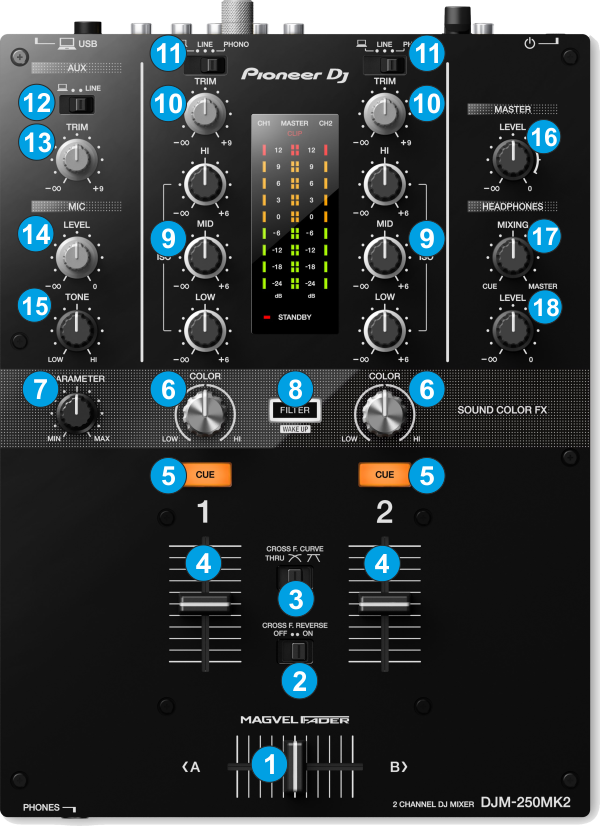DJM-250MK2
TOP PANEL CONTROLS

- CROSSFADER. Blends audio between the left and right channels/decks.
- CROSSFADER REVERSE. Set to ON to enable the reverse Crossfader behavior. When enabled, only Left Deck will be output at far right CF position and vice versa.
- CROSSFADER CURVE. Select one of the 3 available slopes for the Crossfader. When set to THRU, the crossfader will have no effect in audio blending.
- VOLUME. Use these faders to adjust the Output Volume of each mixer channel.
- CUE. Use these buttons to send one or more channel's pre-fader signal to the Headphones Channel for monitoring. When engaged, the button will be lit.
- *COLOR. Use these knobs to adjust the amount of the Filter Color FX to each of the Mixer channels. No Effect is applied when the knob is at 12 o’clock position.
- *COLOR PARAMETER. Use this knob to adjust the Resonance of the Filter Color FX.
- *FILTER. Use this button to turn on/off Filter Color FX on both Mixer channels.
- EQ HI/MID/LOW. Use these knobs to adjust the high (treble) / middle (mid) / low (bass) frequencies of each mixer channel.
* Note : The Filter/Color button and knobs of the DJM-250MK2 are applying a hardware Filter Effect to the audio signal of each mixer channel, and are not assigned to any VDJ action. Therefore, the COLOR/FILTER knobs in VirtualDJ GUI will not be moved/enabled while these are adjusted from the mixer. You can still use the VirtualDJ Filter/Color Effects from the GUI.
Even though the COLOR knob sends MIDI and can be assigned to a VDJ script action (e.g. as .. filter ) , keep in mind that they will still apply the hardware Color FX, so it's not recommended to do so. - TRIM. Adjusts the input audio level (gain) up to +9db of each mixer channel. No boost or cut is at 12 o’clock position.
- INPUT SELECT. Set this switcher to the appropriate position to define which Channel Input will be routed to the 2 Mixer Channel Outputs
Set to USB position to route a VirtualDJ deck output to a mixer channel.
On PHONO/LINE positions the audio signal from the Inputs 1, 2 and 3,4 at the rear panel) will be routed directly to the Output of CH1 and CH2 Mixer Channels respectively. In this case the sound from the computer’s decks will be muted. Use this position to route external analogue media sources.
Set to USB position to use a Timecode (DVS) system. - AUX SOURCE Use this switcher to select the source to be routed to the AUX Channel. Its signal will be routed to the Master Output.
Set to USB to route the VirtualDJ Sampler to the Master Output.
Set to LINE to route the audio signal of the external audio source, connected at the rear panel of the DJM-250MK2 - AUX LEVEL. Use this knob to adjust the level of the selected AUX Source. When the USB AUX Source is selected, the knob will adjust the Volume of the VirtualDJ Sampler.
- ** MIC LEVEL. Use this knob to adjust the Input level of Microphone Input (connection at the rear panel).
- ** MIC TONE. Use this knob to adjust the tone of the Microphone Input.
** Note: The Microphone Input (connection at the rear panel) is not part of the UAB Audio interface, therefore it cannot be included in VirtualDJ Audio Setup, neither can be controlled from the Microphone controls from the VirtualDJ GUI. - MASTER LEVEL. Use this knob to control the Output level of the Master Output.
- HEADPHONES MIXING Use this knob to mix between CUE and Master MIX in the Headphone channel. When all the way to the left, only channels routed to Headphones (via the CUE buttons) will be heard. When all the way to the right, only the Program mix will be heard.
- HEADPHONES LEVEL. Use this knob to set the volume to the Headphones Channel
Note: Even though the device is offering hardware mixing operations, all the buttons/knobs/faders of the Pioneer DJM-250MK2 send MIDI messages and most of them are assigned with VirtualDJ actions and their movements will be shown at the VirtualDJ GUI (fake mixer mode).
Therefore it's not recommended to disable the fake mixer modes or assign to any different action.
Front & Rear panel





